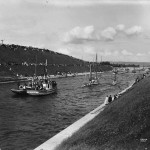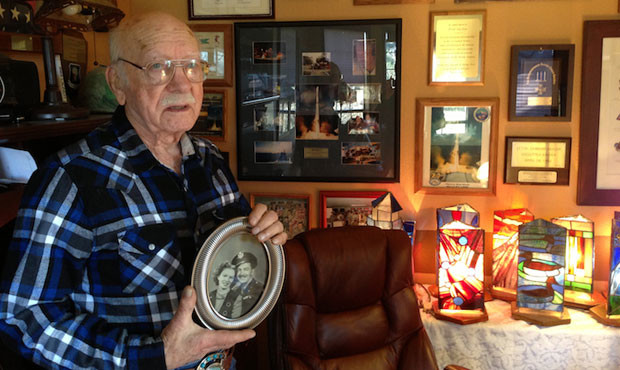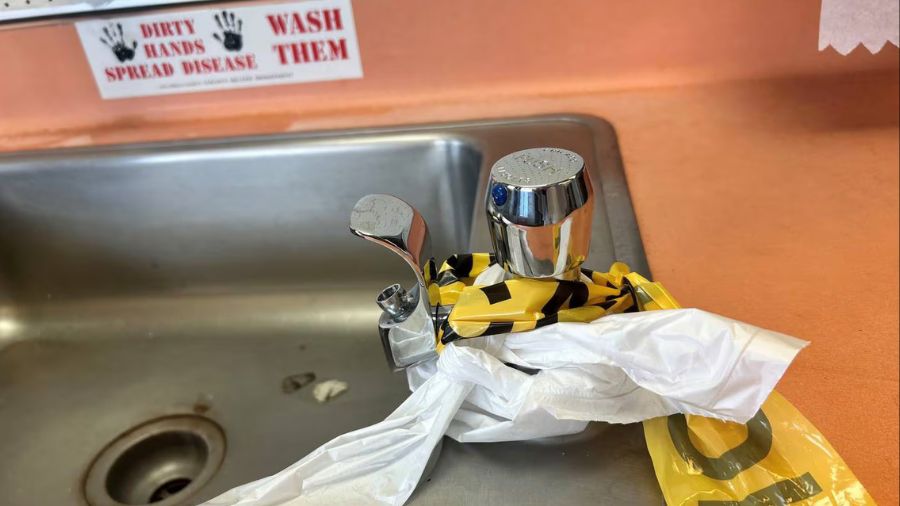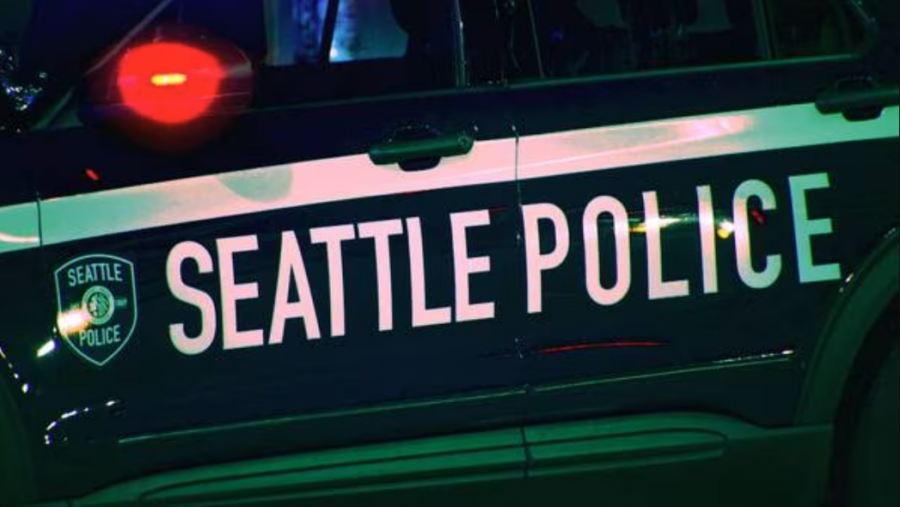Centennial reveals complicated legacy of Ballard locks’ namesake
Jun 28, 2017, 6:44 AM | Updated: 9:49 am
At an Independence Day celebration in Seattle on July 4, 1854, Thomas Mercer suggested giving the name “Lake Union” to the body of fresh water just north of what’s now downtown. Native Americans had called it “small lake” (in their Lushootseed language) for centuries.
It was an inspired – and aspirational – suggestion because Mercer (and others) correctly predicted that Lake Union would one day become part of a permanent water connection to move goods and people between Puget Sound and Lake Washington.
Other routes were considered, and considerable soil was moved at the north end of Beacon Hill as part of the plan, later abandoned, to connect Lake Washington directly to Elliott Bay. A canal was even considered between Lake Union and Smith Cove, just north of Elliott Bay.
This Fourth of July weekend, the Army Corps of Engineers and a confederation of local heritage groups will begin commemorating the 100th anniversary of the fruition of Mercer’s vision. A series of programs is scheduled to take place in and around the locks in Ballard and along the route of the ship canal – that was finally dedicated 63 years after it was first publicly proclaimed. And you thought Bertha took a long time.
But behind the festivities is the complicated and little-remembered legacy of the man who gets most of the credit for the locks and the ship canal, and for whom the locks were named by the US Congress in 1956.
Hiram Martin Chittenden was a lot of things. He graduated from West Point and served in the US Army Corps of Engineers, designing and overseeing construction of roads and bridges and other military and federal government infrastructure, mostly around the West. He also researched and wrote well-regarded histories of Yellowstone, fur trade in the American West, steamboat navigation of the Missouri River, and the life and travels of Catholic missionary Father DeSmet.
Chittenden, who was born in New York State in 1858, was also something of an astute politician. Throughout his career, he was able to clearly communicate with the men he led, with his superiors, with members of Congress, and even President Teddy Roosevelt, to move projects forward.
When Chittenden was sent to lead the Seattle District of the Corps in 1906, he was already gravely ill from years of overwork and a lingering case of typhoid. In four years on the job with the Corps in Seattle, he settled issues related to the location and design of the locks and ship canal, secured the necessary public funding, and gave the project the momentum it had lacked.
Jim Ryan retired from the Corps in 2007 and now spends his time at the locks as a volunteer. He’s spent countless hours researching Chittenden’s engineering and technical papers.
“I think the most impressive thing to me is that he was able to bring all these people together and get the project completed,” Ryan said earlier this week. “It had been foundering for 20 years there [and] everybody was out trying to do something, but they really didn’t have the funding of the knowledge to really get the thing completed.”
Chittenden retired from the Army Corps in 1910 – six years before the locks would be completed – by which time he was paralyzed below the waist. But that didn’t stop him from being elected in 1911 by King County voters as a founding commissioner for the Port of Seattle. Chittenden also served as founding president of the commission and was reelected to a second two-year term in 1914.
Meanwhile, construction of the ship canal had continued in Chittenden’s absence.
The locks opened for business on August 3, 1916. They kept saltwater out of freshwater Salmon Bay and allowed transfer of vessels between sea-level and tidal Puget Sound and Lake Union, which was freshwater and several feet higher. A few weeks later, a temporary dam was removed, and water gushed from Lake Union into the west end of the Montlake Cut. That autumn, a temporary dam was removed from the east end of the Montlake Cut, and water rushed from Lake Washington. The level of Lake Washington – which, because of natural topography, was higher than the level of Puget Sound and higher than Lake Union – dropped nine feet.
The entire Lake Washington Ship Canal, stretching from Salmon Bay to the Montlake Cut, wasn’t officially dedicated until July 4, 1917. Why wait so long? One reason for the delayed celebration was the construction of the Fremont Bridge, which wasn’t finished until mid-June of 1917.
The summer of 1917 was a heady time to celebrate America’s birthday and the opening of the ship canal. The US had only just entered what became known as World War I. Camp Lewis was in the works at what’s now JBLM. Patriotic fervor ran high as boats paraded along the canal before adoring crowds, and an early Boeing aircraft flew overhead.
Hiram Chittenden’s health, however, had further deteriorated, and he’d been forced to step down early from his second term as Port Commissioner. As it turned out, Chittenden was already ailing from the health problems that would take his life that autumn at age 58.
In his relatively short life, Chittenden accomplished much. But he also managed to leave behind a written record – and elements of the ship canal project – that some now find challenging.
A biography written by the late Oregon historian Gordon B. Dodds in the 1970s and recently reissued — based on Chittenden’s diaries and other papers — reveals that Chittenden had some fairly extreme ideas about Native Americans.
Dodds quotes Chittenden regarding the removal of Native Americans from their ancestral homes:
“It was the problem of how to commit a great wrong without doing any wrong—how to deprive the Indian of his birthright in such a way that he should feel that no injustice had been done to him. It was the decree of destiny that the European should displace the native American upon his own soil. No earthly power could prevent it.”
Dodds writes that Chittenden had little to no regard for the practice during the late 19th century of negotiating treaties with Native American Tribes.
“He arraigned especially the treaty method,” Dodds wrote, “arguing that it would have been far better for the nation to have summarily taken the land of the Indians without using the face of the treaty system to legitimatize agreements between unequal powers.”
Dodds writes about Chittenden’s “faith in the superior virtues of the Anglo-Saxon race” and that Chittenden:
“[W]as a full-fledged Anglo-Saxon imperialist, arguing that nations must grow and expand, and he cheered Britain’s victory in the Boer War and the United States’s acquisition of the Philippines and the Panama Canal Zone. When he contemplated the cession of Louisiana to the United States, Chittenden described the sentiments of the inhabitants in racial terms: “The new order of things was by no means generally acceptable to the foreign element of the population, either Spanish or French. They saw in it the death knell of their peculiar customs and laws, and they knew that the enterprising spirit of the Anglo-Saxon race would crowd them out of the avenues of industry and commerce even on the very soil where they had lived and toiled from infancy.” This philosophy of race was also evident in Chittenden’s condemnation of sentimental humanitarians who wished for a different outcome of the Indian policy of the United States. They wished to see the races share the land as equals, but their desire, according to Chittenden, was based upon a false assumption: ‘It ignores the operation of that evolutionary process by which a weaker race disappears before a superior in spite of all that laws or military force can do to prevent.’”
Though Dodds’ book was originally published in 1973, Chittenden’s writings on Native Americans came as a surprise to some members of the volunteer coalition that’s been working for the past few years to organize the locks centennial.
Michael Herschensohn is a former director of MOHAI and is the current president of the Queen Anne Historical Society. He’s a member of the centennial group, and he says that his own thinking about Hiram Chittenden evolved, as did the group’s approach to the locks’ namesake.
“I knew about him primarily as the engineer of the locks, and that was enough for me to know,” Herschensohn said. “To know his name and why his name is on the locks . . . and then people started reading these materials and said, ‘Whoa, wait a minute let’s be careful about how we deal with the Native American issue related to the history of the locks.’”
Herschensohn says very clearly that the events planned for the centennial are a commemoration, not a celebration – because the project had both positive and negative effects – and that one of the hopes for the commemoration is to inspire a community dialog about the past.
“If we hadn’t had the centennial, there’s an awful lot we wouldn’t have thought about,” Herschensohn said. “So this has that function of taking your attention away from all the other things you’re doing and focusing it on this one particular event in the history of the community, and trying to understand it in-depth as a community, rather than as an individual who might read the Chittenden book.”
Besides some inflammatory language in an old book, the ship canal as designed by Hiram Chittenden took its toll on the landscape – and on one group of Native Americans in particular.
When the locks became functional, the level of Salmon Bay rose by a few feet, displacing homes, businesses and Native camps previously at the water’s edge. As mentioned above, Lake Washington dropped nine feet, completely reshaping the shoreline. The most radical change came at the south end of Lake Washington, where the Black River literally dried up.
The Black River used to drain from the lake and connect to the Duwamish River and Elliott Bay. Though it was too shallow for big boats or ships, it was perfect for Native canoes. It turns out that there was a Duwamish village for hundreds of years along the Black River in present day Renton.
Duwamish Tribal member James Rasmussen is coordinator and director for the Duwamish River Cleanup Coalition. He clearly sees the economic value created by connecting Puget Sound to Lake Washington 100 years ago, and he understands why settlers wanted to make that happen as early as the 1850s.
But, Rasmussen says, something about Seattle changed around the turn of the 20th century.
“If you go back to the 1870s and 1880s and the first wave of settlers that were coming here, they actually had a good relationship with Indian people,” Rasmussen said. “And then into the 1900s, all of a sudden there was another wave, and those people had a more, we’ll say ‘traditional’ view of Indian people. In other words, ‘we don’t want them around, a good Indian is a dead Indian’ kind of thing.”
It was open season not only on the landscape, Rasmussen says, but the attitude of the early 20th century arrivals – people like Hiram M. Chittenden, he says – toward people, too, was “’we don’t care about not only Indian people, but we don’t care about anybody who’s going to stand in the way of so-called industry … and the way we want to develop the city.’”
One of James Rasmussen’s ancestors lived at the Duwamish village along the Black River. He was there in the autumn of 1916 when the canal opened and the lake level dropped.
That’s when the Black River disappeared.
“’I look down at my canoe landing, and it’s dry,’” Rasmussen said, relating his ancestor’s story. “’There are pools of water where there was a river, and salmon are trapped. The mostly white people are bringing gunnysacks to pull up the salmon and they’re having a great old time.’”
“But the people who lived there knew that this means they can’t live there anymore,” Rasmussen said. “There would be no transportation for them, no way of making a living there, no way of being able to do the things that they were doing before.”
Duwamish Tribal chair Cecile Hansen says the ship canal project “erased” the Duwamish village along the Black River. An archaeological dig there in 1980 found artifacts, as well as evidence of posts from at least one giant longhouse and several other buildings. The Renton Shopping Center now occupies the site near where Rainier Avenue intersects Sunset.
“When I go by there, I get a bad feeling because, you know, villages along the waterways, along the hill above any village they buried their people,” Hansen said. “So I would say [the archaeologists or construction crews] probably found remains and probably . . . I don’t know,” she said, her voice trailing off.
Early plans for the ship canal included a second set of locks between Lake Washington and Lake Union that would’ve kept Lake Washington at its natural level and which would’ve meant that the Black River didn’t disappear. Did Hiram Chittenden’s feelings toward Native Americans inform his decision to do away with the Lake Washington-Lake Union lock, or was it only because that was a cheaper and therefore more feasible option? Answering this question, one way or another is probably impossible.
Retired Army Corps staffer Jim Ryan says it’s also impossible to judge Chittenden’s words and actions by today’s standards.
“My take on the thing [is that] he was an Army officer, and he had numerous assignments,” Ryan said. “It’s hard for me to say what that was like 100 years afterward. I personally don’t think he was better or worse than anybody else in the timeframe. As time has gone on, our mores have changed.”
The role of the locks and ship canal has also changed over the past century. The industry envisioned for Lake Washington didn’t materialize on a grand scale – other than the old shipyards in Houghton or the whaling fleet in Bellevue – and now the waterway mostly serves recreational boaters.
And in the recent past, what seems like a missed opportunity – regardless of Chittenden’s motives then or legacy now – is that no tribes took part in planning for the centennial, though a representative of the Suquamish Tribe attended a few of the initial meetings.
James Rasmussen says there’s much that could be done to foster a real and continuing dialog about Native Americans in Seattle on an ongoing basis, not just around anniversaries or special events.
“I know I get asked and the tribe gets asked ‘We’d really like to have you come out and speak at this event and we want to show you respect’ and everything else,” Rasmussen said. “Well, as long as it’s that day then you do [show respect], but as far as involving the tribe in real discussions, it doesn’t happen.”
Rasmussen points to the Duwamish Tribe’s ongoing attempts to secure federal recognition, and to the recent plan to revitalize Seattle’s waterfront – which he sees as examples of unfair treatment of Native Americans.
In planning for the makeover of the waterfront “Native people were an afterthought in that they didn’t even reach out right away as far as what did some of the recognized tribes in the area think about it what kind of story did they want to tell in this place,” Rasmussen said.
Despite the challenges, James Rasmussen remains hopeful and forward-looking. What does it mean to look back 100 years and commemorate the locks and ship canal?
“What this means is, can we look forward in a different way than we have now?” Rasmussen said. “Can we look forward where we can balance fish and wildlife, especially salmon, as far as the locks are concerned, but [also] communities that are impacted and all those things, but also still have thriving industries, thriving communities and thriving wildlife? Can we show that leadership now?”
“It is possible . . . it really is possible if we all work towards the same goal,” Rasmussen said.
“And that’s a better city.”





















